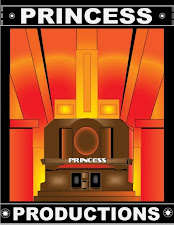I had occasion to visit Megan (Anderson) today, delivering her a CD with some photos from all the 2012 concerts. She is working on a new brochure all about the Princess and what she has to offer. It's always nice to talk to her and just walk around the Princess.
The Princess is just so much more than she was back in "our" movie going days, and her potential has yet to be fully described or seen. There is so much more coming in the future, and not even those of us that love her, and visit her often, can even foresee.
The walls could tell us more than our own Princess histories. They could tell us about all the laughter, the broken hearts, the found loves, and the sweat and tears of those that have labored within her, and even of those that extinguished two intense fires.
However, I would like to think that the walls can see the future. If they could talk, they would end every story of history with one of the future, and how the music, the laughter, and stories will continue.
That's just some of the feelings that I get when I'm there, especially when I'm there alone, in one of the dark hallways, or just behind the curtain on stage. The Princess is alive in our brains, and roams in the corners of our nostalgic hearts.
Some of that "Princess love" was displayed this past week, when the Gasparetti's donated a Yamaha Baby Grand.
The piano is sitting in a locked air conditioned room, just waiting for it's first opportunity to show it's stuff!
It has some cool stuff to strut too! Hanging beneath, on the right side of the player's sitting position, is a control unit called a "disklavier".
Disklavier (pron.: /ˈdɪskləvɪər/) (from Wikipedia) is the brand name for a group of piano-related products made by Yamaha Corporation. It was introduced in the United States in 1987.
The various forms of Disklavier are essentially modern pianos that use electromechanical solenoids and optical sensors connected to LEDs
allowing them to play notes and use the pedals independently of any
human operator. Most models are based upon real acoustic pianos and have
been engineered such that the sensors and electromechanical elements do
not interfere with or affect the normal playing of the instrument. They
include the ability to store data, including performance data played by
a human pianist, and then use that data to replay/reproduce the
performance. Disklaviers also have inputs for data from MIDI and from several storage devices including floppy disks, CD-ROM, serial cables, and USB.
They will be reminded to occasionally stop, in a quiet hallway, or just behind the dark curtain, and listen to the stories, while at the time, living their own.










.jpg)





No comments:
Post a Comment